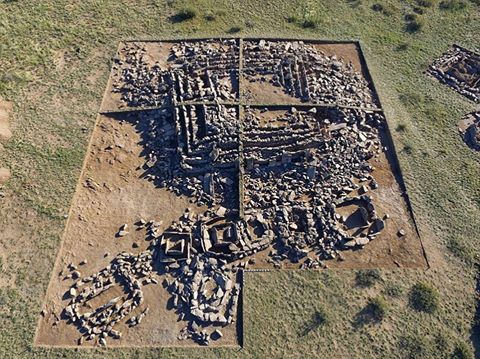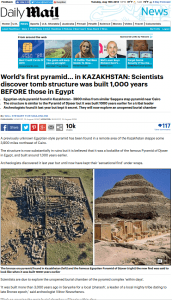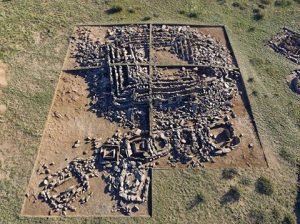

Floating around some of the archaeology and science groups is a new “discovery” of a pyramid “older than those of Egypt” found in Kazakhstan. And the headline bills it as the “world’s first pyramid.”
Is it? Not quite. And the answer is actually in the article itself if you take it at face value. Here are some quotes:
“The structure is now substantially in ruins but it is believed that it was a lookalike of the famous Pyramid of Djoser in Egypt, and built around 1,000 years earlier.”
“It was built more than 3,000 years ago.”
“Pictures of the archeological site emerged today highlighting a ‘step mausoleum’ named the Begazinskaya (or Begazin) Pyramid, built between 3,000 and 3,500 years ago.”
“The Djoser ‘step pyramid’ is an archeological jewel in the Saqqara necropolis, northwest of the Egyptian city of Memphis. It was built around 2700 years BC for the burial of Pharaoh Djoser.”
2700 BCE was over 4700 years ago, putting a construction time for Djoser’s pyramid over a 1,000 years earlier than the discovery in Kazakhstan.
The reign of Djoser was between 2630-2611 BCE so his pyramid was probably built sometime during that 19-year period by his architect, Imhotep.
This, I think, is an example of a writer simply not paying attention in his desire to create a headline that grabs attention (the click-bait). “World’s first pyramid” certainly appeals to an audience immediately and creates a need to click and see–even if you don’t believe the claim. I admit, it was my skepticism that made me click it.
But reading these things with a critical eye helps spot the problems. It’s just too bad Stewart didn’t catch his mistake early. If I’m right, the Daily Mail will retract or amend the headline since it’s false, and that’s why I included the screen grab above.

There are other problems with the article as well. For instance, Stewart writes that, “Archaeologists discovered it last year but until now have kept their ‘sensational find’ under wraps.”
This is probably only partly true. They shared data with the professional community about the necropolis in Begazy in 2014 ((Beisenov, A.Z., et al (2014). Architectural features of the burial sites for elite of Begazy-Dandybai culture of Central Eurasia (e.g. Begazy Necropolis). Procedia-Social and Behavioral Sciences, 122, 248-352)) along with photos. They probably didn’t share with the media until the majority of excavations were complete to avoid potential looting. I would imagine they expect to wrap up their work this season since they’ve made the site more public.
The other thing that bothers me is the literature I’ve seen from the professionals so far have not used the word “pyramid.” They’ve described their excavations as uncovering a necropolis and a mausoleum. And in the photos of the site, there doesn’t seem to be enough material lying around the footprint to be part of a pyramid. I wouldn’t be surprised if this is a description completely made up by the writer or an editor at the Daily Mail.
Leave a Reply
You must be logged in to post a comment.